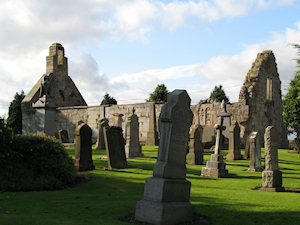
The Village
The village of East Calder is built on four estates. The largest part of the village was built on the Calderhall Estate which extended South of a line from the bridge between East and Mid Calder to the East Kirk burn and along Main Street to Park Avenue. A wall and hedge denoted the Eastern boundary there.
To the West of Park Avenue the land was part of the Almondell Estate owned by the Earl of Buchan. South of the Calderhall Estate was the Langton Estate. The land North of Main Street between the East Kirk burn and the boundary of Almondell Estate was owned by the Pumpherston or McLaggen Estate.
Population
The making of the roads further increased the population. After the 1745 rebellion, road making was in full swing. The road through the village was known as the Great Turnpike Road. Previously used by the drovers who herded their beasts from Edinburgh, others drove their cattle from the Highlands and Islands via Perth, Crieff, Falkirk and Linlithgow to Mid Calder which was a market village, hence Market Street.
With the widening of the road many local people were employed, among them some of the small landowners. The wages earned enabled them to purchase more land and as a result there were more grazing cows in the district. The district was situated in
Mid Lothian at this period of time and, with part of West Lothian, supplied Edinburgh with a large share of butter and buttermilk.
With the advent of the Railway in 1846 the population of the villages increased. East Calder in 1861 had a population of 552, in 1871 it was 589, in 1881 the total was 754 and in 1891 it grew to 974. Today it is in the region of 5,600.

The 7 Wells
There were seven wells in the village. Five were situated in the Main Street and two in the "Brick Raw", so called because the houses were built of brick, whereas the village was predominantly stone built. The name for this part of the village is Burnside Terrace.
The wells were in the village before the 1900's. At this time, the East Kirk burn was forded with a wooden bridge spanning the waters for the use of pedestrians. The East Kirk burn is now piped under Main Street but it can still be seen in the park and down Burnside Terrace where it then flows freely into the River Almond.
Churches
In the old graveyard stand the ruins of St Cuthbert's Church. This pre-reformation building was built in the year 1148 and dedicated to St Cuthbert.
East Calder at this period of time was known as the East Kirk of Calder and the church was originally a Rectory/Presbytery. Small houses clung to the walls of this ancient place of worship. It was Cuthbert who travelled all over Lothian, sometimes on horseback, sometimes on foot, endeavouring to persuade the people to give up their pagan worship and become Christians.
Within the ruined walls of the Church is the burial place of the Hares of Calder Hall and the Wilkies of Ormiston House, Kirknewton. The Church had a belfry at the west side of the gable end. The bones of St Cuthbert are deposited in Durham Cathedral.
The establishment of the Church of St Cuthbert as a place of worship constituted the beginning of our community. It was first mentioned by Randolph de Clere who had a grant of the manor from Malcolm IV in the year 1160 with the title of Baron.

The old Churches in Kirknewton and East Calder ultimately decayed. A report was sent to the Presbytery in 1627 stating that the Kirks of the two villages were "ruinous’ and that 'the roofs already decayit'. The Kirknewton Church in the graveyard was built in 1146.
Despite the reports it appears that very little was done to preserve the Churches and the condition of the buildings worsened. The Parish Church for the new parish was built in 1750 on the outskirts of Kirknewton.
Eventually it was decided to build a new Church in East Calder. A fund was set up in 1775 and the new Church was ready for use in 1777. A communion token was struck to commemorate the achievement. On the token the following words were inscribed: ”East Calder Congregation" on one side and on the other ”Let Hrst a man examine himself 1777”.
There is an old book dated 9 November 1775 stating how the people of East Calder proceeded to petition the Presbytery for a supply of sermons and how the Church was built.
The second Church in East Calder was built on ground gifted to the Church by Sir Alexander Houston of Calder Hall. As there was no resident Minister, lay preachers and Ministers travelled by coach from Edinburgh. Travel in those days was by pony and trap and in the winter journeys could be hazardous.
The third Church built in our village was built in 1886. This is our place of worship today.
The effort to raise the money required for such an enterprise was extraordinary. A bazaar was held in Edinburgh and ran for two days. Colonel Hare, who by then was the owner of the Calder Hall estate, having purchased it from Sir Alexander Houston, gave the ground where our present Church stands.
In 1899 it was decided to make the second Church into 4 houses. Mr Aitkenhead, a local contractor, gave a loan of £500 towards the project. The work was started and completed in the same year. The rent for a house was £10 pa. The houses were the homes of many villagers for many years until the building of the council houses in 1927. The loan of £500 was repaid to the heirs of Mr Aitkenhead in 1945.